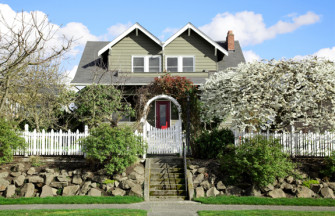Top 10 Spring Home Improvements
 With memories of snow and cold fading, it’s time to remind home owners to take stock of important work to be done for themselves and potential buyers down the road. Keeping on track with seasonal maintenance will lower costs and raise value. Besides cleaning closets and planting flowers and cool-weather vegetables, spring should involve scrutinizing the condition of a house following the rough winter. Repairs and replacements won’t just help owners enjoy their properties more; they’ll also keep energy costs down as hot weather rolls in and attract more buyers.
With memories of snow and cold fading, it’s time to remind home owners to take stock of important work to be done for themselves and potential buyers down the road. Keeping on track with seasonal maintenance will lower costs and raise value. Besides cleaning closets and planting flowers and cool-weather vegetables, spring should involve scrutinizing the condition of a house following the rough winter. Repairs and replacements won’t just help owners enjoy their properties more; they’ll also keep energy costs down as hot weather rolls in and attract more buyers.
Replace Windows
If your home felt drafty this past winter and have single-pane windows, there’s a good chance those were one of the culprits. But replacing them all can be costly — $400 to $500 per window, plus $100 to $150 for installation. Whether that’s the place to spend dollars should depend on how long home owners plan to stay put or what houses listed in their neighborhood offer if they’re selling. A less costly alternative can be to add storms, caulk, weather strip, or rim joists in a basement. To also help with costs, gradually replace windows in any room that you remodel. This may make the cost less prohibitive.
If a seller’s furnace and boiler were on their last legs this past winter, it may be time to install a new one, or at least provide sellers with a credit toward new equipment. Any choice should carry an EnergyStar label for best results. Existing systems still in good condition should have filters checked monthly and replaced when dark and clogged. For greater energy efficiency, install heat exchanges that provide both heat and air conditioning. This can be less costly than a new central air system with new ducting and a new furnace.
Clean Air Conditioning Units
Before summer temperatures rise and HVAC pros are swamped, home owners should clean coils and change filters so their system doesn’t have to work as hard. Also have drain lines cleaned, so moisture is eliminated. If you haven’t had air conditioning, now’s the time to weigh choices of a central system, heat exchange, or room units.
Install More Insulation
A home’s first line of defense to stop cold or hot air — depending on the season — should be the attic. An energy audit can determine how much more is needed, if you already have some. For cold climates, installing electric or hydronic radiant heat under bathroom and kitchen floors will provide comfort next season.
Switch out Inefficient Appliances
Sometimes appliances are no longer smart to repair. The determining factors for that should be their age and the cost of repair versus replacement. Here, too, top choices carry an EnergyStar label. If you need to replace most of their kitchen equipment and have a limited budget or plan to move, prioritize and first switch out the range, followed by the refrigerator, dishwasher, and microwave — in that order.
Repair or Replace Roofs, Gutters and Downspouts
Because of the tough hurricane season last fall and the winter blizzards, roofing contractors in many parts of the country have been busy. Those who need new roofs may consider architectural asphalt shingles because of their long warranties (often 50 years), affordable prices, and attractive appearances that work with many house styles. In addition, many contractors have the equipment and experience to install roofs of this material, as opposed to metal. Home owners should have gutters and downspouts cleaned come spring so that water can flow through them; gutters should be angled away from a house to stop water pooling around a foundation and seeping into the basement. Gutter covers can be helpful but often don’t eliminate all debris.
Paint
Damage often shows up at this time of year, especially in climates where there’s been a lot of snow melting or winter rains. Use the time to reassess your color choice for better curb appeal. Even changing the front door’s color can make a difference.
Prune Trees
Cutting limbs that may have been damaged during winter and that might fall on a roof or allow squirrels to enter a house is smart, and it can be a cost savings later on. Called “thinning out,” this method gets excess foliage trimmed to allow more natural light into a house—and cut down on artificial illumination. A certified arborist will know the best ways to do this without removing too much of a canopy, which is useful for privacy and shade.
Mulch Plantings
Along with fall, spring is a key mulch time. Mulch helps plants thrive by holding back weeds, retaining moisture so soil doesn’t dry out, and adding a tidy look. Use bark, shredded fir, leaves, straw, or grass clippings.
Replace Lightbulbs
When it comes to artificial light, most contractors recommend switching burned-out bulbs to LEDs, which last longer than incandescents, consume less energy, and have come down in price — now often just $10. Quality has improved, too, and they’re dimmable and available in colors.
One more thing: Before you hire anybody to take on work, get a written estimate. Better to be safe than sorry.
